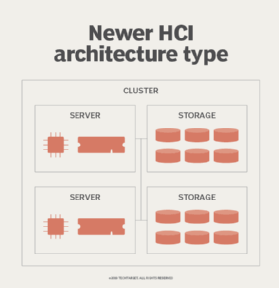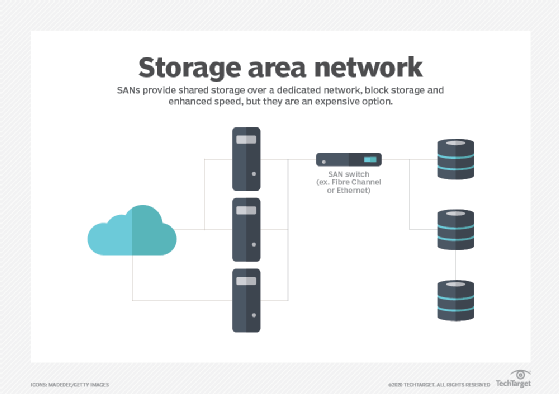
apops - Fotolia
SAN vs. HCI: 5 questions to ask
SAN or hyper-converged infrastructure? Which one will become your organization's on-premises technology choice? Discover which approach may ease complexity and control costs.
Hyper-converged infrastructure is growing in popularity as an alternative to SAN, but it may not be the right choice for every organization. As enterprise-class organizations consider their future on-premises storage needs, they will likely have to decide between upgrading an existing SAN or transitioning to HCI. The SAN vs. HCI decision isn't an easy one, however, and there are key questions IT managers should answer as they look to the future of their infrastructure.
What are your storage scalability requirements?
One of the first questions to consider is that of SAN vs. HCI scalability. This means more than just raw capacity. IT managers must also decide whether a given approach will provide the redundancy and data throughput required to service workloads for the foreseeable future.
When it comes to an enterprise SAN, budget is often the limiting factor for scalability and other aspects. While budget is no doubt a consideration for HCI as well, the node architecture ultimately dictates the maximum scalability that can be achieved. There is not only a limit on the total capacity and storage IOPS that each node can deliver, but a limit on the total number of nodes that can exist within a cluster. It is possible to deploy multiple HCI clusters, but this increases management complexity while also potentially creating storage silos.
What role will storage play within the organization?
It might seem obvious, but it is important to consider how the storage will be used. SANs are a good general-purpose storage solution, but HCI tends to be more specialized. Many HCI platforms today are designed for a specific use case, such as for hosting VMs. Likewise, vendors offer HCI products that are meant to provide disaster recovery capabilities or act as virtual desktop hosts.

One reason why use case is such an important consideration is that HCI platforms generally don't support the provisioning of raw storage for external connectivity. It may be possible to make storage externally accessible in a roundabout way, such as configuring a VM to act as an iSCSI target, but you may not be able to make the storage directly accessible to external workloads.
What is the state of the existing storage investment?
The decision of SAN vs. HCI storage adoption can't be made in a vacuum. IT managers must also consider the organization's existing storage investment.
In some ways, this question seems completely logical. If an organization has gone all-in on SAN storage, then it's probably unrealistic to expect it to abandon that investment and switch to HCI. However, there are situations in which an organization's previous storage investment may play less of a role in the decision.

Imagine for a moment that an organization invested heavily in SAN storage a decade ago, but over the last couple of years, it has been aggressively migrating to cloud storage. This might be a situation in which transitioning to HCI is justified.
In this example, the organization's SAN storage is less important than it once was, as evidenced by the cloud migration. The SAN is also probably significantly underutilized, but it's unrealistic to expect an enterprise-class organization to migrate all its resources to the cloud. Some resources almost certainly must remain on premises, such as domain controllers or latency-sensitive workloads. Transitioning these to HCI may enable the organization to walk away from the cost and complexity of maintaining an aging SAN that's no longer used the way it once was.
What are your storage feature requirements?
Early on, HCI deployments provided storage basics such as RAID and storage encryption, but commonly lacked more advanced features such as tiered storage. This was understandable because storage wasn't the primary focus of an HCI deployment. HCI platforms were oriented to use cases such as virtualization or backups. Storage was simply an infrastructure component that enabled the platform's primary function.
More recently, many HCI vendors have decoupled storage from HCI compute resources, making it possible to upgrade storage independently of compute. This addresses one of the biggest pain points of HCI adoption. Just as importantly, some HCI vendors have begun making HCI storage more feature-rich by introducing capabilities such as tiering and erasure coding.
If an organization needs the latest cutting-edge storage features, such as integrated blockchain, then SAN is still the way to go. For those who only need more basic capabilities, HCI may be enticing.
What is the total cost of ownership?
IT purchasing decisions almost always come down to cost. When choosing a storage approach, as with most aspects of IT, it's important to look at more than just the cost of purchasing and deploying storage hardware.
With storage, power and cooling requirements play a major role in the overall cost, as does disk replacement. Some storage products will only allow HDDs and SSDs to be used if they're the vendor's own brand. These proprietary disks tend to be significantly more expensive than commodity disks.
Another area to consider is maintenance. Some storage vendors require customers to purchase a maintenance contract as a condition of the hardware acquisition.







